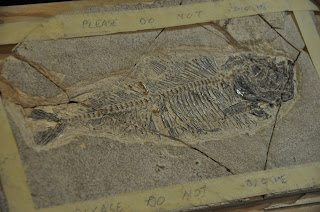Gem & Mineral Show
Excavating Fossils
Saturday is full of activities for children to participate in alongside students and teachers at the U of W.
Our first stop was a table set up for fossil excavation.
The student asked us to smell our fossil and compared it to the likeness of asphalt (the smell of a local construction site.) She went on to explain that these are how fossil fuels are derived!
O & Baby C were quite happy to be donning safety glasses and doing important work!
The most popular exhibit was the Rock Creature craft table.
Children lined up to chose their favourite rock, before detailing them with paint, feathers, googly eyes and pom poms! We were invited to continue on with the show, while our creatures dried off!
As soon as Baby C caught site of the tiny swimming pool, she was not really interested in panning for gold flakes! We could only stay a minute before we wreaked havoc on that exhibit!!
A permanent part of the Earth Sciences Museum at the University is this mounted viewing station, depicting the fate of the Mastodon. The mural on the wall is a fixed feature, but when you use the computer monitor, it gives you options to demonstrate periods of time and the death of the mastodon.
In the Plant Lab, students showed several species of tree rings. She explained that the space between rings indicates warm versus cold seasons (larger spaces indicate longer growth periods in warmer seasons).
She also talked about 'heartwood' being the center of the tree trunk and how tannins play a part in colouring the wood. http://www.thefreedictionary.com/heartwood
Liquid Crystals
O & Baby C used their body heat to change the colour of these thermotropic Liquid Crystals.
https://en.wikipedia.org/wiki/Liquid_crystal
Think Mood Rings of your childhood!
Think Mood Rings of your childhood!
We watched as the test tube seemed to disappear in this Oil & Glass Refraction experiment!
http://www.exploratorium.edu/snacks/disappearing_glass_rods/
DIY Button!
A while back I borrowed a book from our local library that explained that there are six basic machines, most of which were developed many moons ago, but improved upon with advanced technology and design.
http://www.amazon.ca/Explore-Simple-Machines-Great-Projects/dp/1936313820/ref=sr_1_1?ie=UTF8&qid=1445769875&sr=8-1&keywords=explore+simple+machines
I love the simplicity of the base models and how we continue to construct machines today, from these original idea's!
Levers (ex. teeter-totter)
Inclined Plane (ex. ladder)
Wedge (ex. hammer end)
Pulley (ex. water well lift system)
Wheel & Axis (ex. bicycle)
Screw (ex. mason jar lid)
The University used a Button-Making Press as an example of a lever.
At the entrance/exit door there were boxes of 'Free Rocks' for the taking.
We spent quite a while choosing our favourites!
Since our visit last year, the Uni has installed a "Periodic Table Project."
https://en.wikipedia.org/wiki/Periodic_table
The known elements have been featured with art projects representing their properties.
Theodore Grey is the author of amazing visual literature of the elements, on our wish list now! http://www.amazon.ca/Elements-Visual-Exploration-Every-Universe/dp/1579128149/ref=sr_1_1?ie=UTF8&qid=1445769928&sr=8-1&keywords=the+elements
We barely reached half of the exhibits they had available, before calling it a day.
Thank you to the University for enticing your future scientists!













